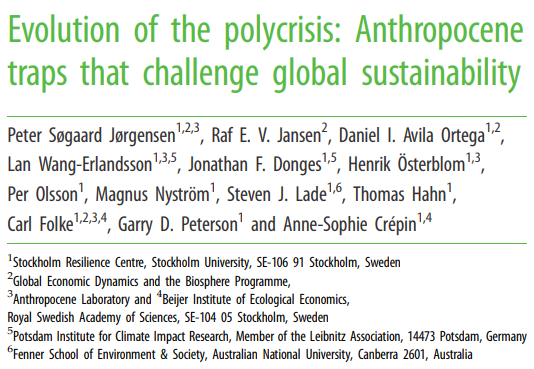The article “Evolution of the Polycrisis: Anthropocene Traps That Challenge Global Sustainability” provides a comprehensive analysis of the challenges posed by the polycrisis in the Anthropocene and offers insights into potential pathways for addressing these challenges. The study identifies five key traps that pose significant challenges to global sustainability in the Anthropocene. These traps include pursuing growth at the expense of well-being, ecological overshoot resulting from continued resource extraction, the instability of global cooperation leading to conflict, increased connectivity leading to contagion, and the pathology of natural resource management. The authors highlight the growing trends associated with these traps over the past 30 years, emphasizing the need for urgent action to address these challenges.
In addition, the study explores the multifaceted impacts of the polycrisis, including the economic implications of corporate financial reporting, the changing purpose of corporations, the material footprint of nations, and the impact of global seafood trade on marine ecosystems. It also addresses social and public health impacts, such as the effects of climate change, the restructuring of stressed coasts, and the disaster of the Aral Sea.
Overview
2. Making sense of human evolutionary traps
Delves into adapting the classic concept of evolutionary traps, extending it to a human and broader Anthropocene context. They introduce Anthropocene evolutionary traps as global phenomena, which unfortunately render certain human practices maladaptive. This maladaptation is defined by its negative impact on human well-being, the severity of which can range from incremental to catastrophic. Significantly, the authors underscore the importance of large-scale regional or global trends in well-being metrics and critical social and environmental processes.
Furthermore, the authors explore a wider approach to defining evolutionary traps in the human context. This involves recognizing debates around the conceptualization of fitness for species with traits shaped by intentional and cumulative cultural evolution. In this regard, they stress a practical understanding of the impacts of evolutionary traps on human well-being. This perspective allows for examining multiple evolutionary dynamics affecting various aspects of human life. Moreover, they highlight the need to consider human capacities, empowering humans to aim for positive impacts on normative goals like well-being.
3. Methods: identifying and analysing Anthropocene traps
Details their approach to identifying and analysing potential Anthropocene traps. Importantly, this process was carried out through participatory exercises at the Stockholm Resilience Centre between 2020 and 2022, which included seminars, workshops, and questionnaires. The process of pinpointing and understanding traps was broken down into three main stages:
- Firstly, setting system boundaries: This crucial stage involved defining the scope and boundaries of the systems in question, which provided a practical framework for spotting traps within these systems.
- Secondly, familiarization with evolutionary dynamics: Participants engaged in activities that helped them thoroughly understand them. This foundational stage laid the groundwork for recognizing traps significantly influenced by these dynamics.
- Lastly, identification of evolutionary traps: In a collaborative approach, the participants combined their expertise to identify and suggest potential Anthropocene traps.
The insights gathered from these exercises notably laid the foundation for evaluating and analysing the traps. Moreover, the authors also explain the criteria used to classify a phenomenon as a potential Anthropocene trap. Emphasized the traps’ evolving nature, their negative impacts on global human well-being, and the trapping mechanisms that make escaping their effects difficult once triggered.
4. Analysis of traps
Evaluates the 14 identified Anthropocene traps involved in data analysis, a literature review, and expert opinion. Importantly, these elements have been cross-validated internally and include input from all authors. The concrete indicators chosen for this assessment are based on the authors’ expertise and available evidence. The analysis of the 14 traps was conducted in the following manner:
- Firstly, there was the evaluation of trap growth. The authors examined whether the traps expanded in scope and considered their connection to evolutionary theory and selected indicators.
- Secondly, the traps were categorized based on evolutionary theory. This classification allowed for a deeper understanding of the dynamics influencing each trap.
- Lastly, trap interactions were explained: The authors illuminated dynamics and the reinforcing interplay among Anthropocene traps.
This evaluation and analysis offer insights into the current phase and severity of the 14 traps, providing a comprehensive perspective on their evolution and potential impacts. Underscores the systemic nature of the crisis, emphasizing the reinforcing interactions among Anthropocene traps and stressing the urgency of comprehending and addressing these challenges.
5. Groups, trends and interactions of traps
Analyzes the identified Anthropocene traps, paying close attention to their grouping, trends, and interactions. This analysis examines their evolutionary dynamics and interconnections, focusing on several key components. Firstly, the authors categorize the Anthropocene traps based on their evolutionary dynamics. They align these traps with three theories, represented as causal loop diagrams. These theories include multi-level selection for increasing social organization levels, reinforcing the dynamics of technological innovation, and masking interactions and global change rates.
Secondly, the growth of the traps as a phenomenon is assessed. This assessment considers their relation to evolutionary theory and the chosen indicators. Interestingly, the authors find that 10 of 14 traps are growing as a phenomenon, with distinct trends observed across different trap groups. This analysis provides critical insight into the traps’ evolution and potential effects on human well-being. Lastly, this section also describes the interactions between traps. It is important to note that the prevalent reinforcing interactions observed among Anthropocene traps are underscored.
6. A model of trap evolution
Outlines a conceptual model that effectively represents the general phases of Anthropocene trap evolution. Specifically, this model includes four phases: initiating a new trajectory. Secondly, global scaling of the trajectory, concealed signs of adverse effects on the global system, and finally, the activation of trapping mechanisms with an increasing risk of negative impacts. The authors elaborate on the processes in each phase, underscoring the significance of innovation, sequential selection and adaptation, and multi-level selection in the initiation and scaling phases. To demonstrate the practicality of this model, the authors use antibiotic resistance as a tangible example, thereby underscoring its relevance to real-world problems. However, recognizing the current model’s limitations, they stress the necessity for diverse approach combinations to formalize Anthropocene trap modelling.
7. Current phases
Examines the current phase and severity of the 14 identified Anthropocene traps in their assessment. Utilizing the criteria for identifying a potential Anthropocene trap, they have determined that 12 out of 14 traps could potentially be in some stage of the trapping phase, with four possibly only in the masking phase. Interestingly, the other two traps haven’t advanced past the scaling phase. Likewise, the authors underscore the deepening status of many Anthropocene traps, as demonstrated by increasing trends in the selected indicators. They offer detailed findings for the three groups of traps, particularly stressing the likely or imminent activation of trapping mechanisms for several global and technological traps.
8. Severity of traps
Discusses the severity of the identified Anthropocene traps and provide a detailed analysis of their potential impacts on human well-being. They differentiate between two levels of severity: severe traps, which have universally negative impacts on the population and can lead to a decrease in population, and equal-preference traps, which are more challenging to identify in terms of their impacts on the population without a controlled experiment. To gauge the severity of the traps, the authors suggest focusing on the affected domains of well-being, such as food insecurity, undernourishment, and their consequences. In doing so, they underscore the importance of using global datasets and reports to evaluate the current severity of the traps accurately.
9. Navigating traps: evolving toward sustainability
Presents a framework for addressing the challenges of Anthropocene traps and progressing toward global sustainability. They introduce “evolvability,” which they define as a combination of cognitive, social, and social-ecological abilities necessary to evolve in a socially and ecologically inclusive manner intentionally. Identifies five key aspects of evolvability crucial for progressing toward global sustainability:
- The ability to identify traps and establish goals to escape them.
- The ability to understand our position relative to these goals and determine the necessary steps to reach them.
- The ability to reorganize and innovate.
- The ability to anticipate and respond to unexpected events.
- The ability to resolve conflicts.
Additionally, the authors describe global sustainability as a trajectory or state wherein humans enhance their well-being through conscious protection and stewardship of a socially inclusive and biodiverse planetary system. They underscore the need for purposeful cultural evolution and the development of resilience, adaptability, and transformability to attain global sustainability.




